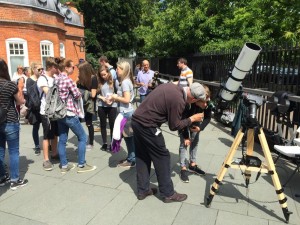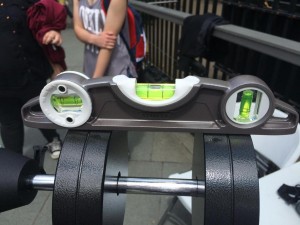June 21, 2015
Summer Solstice Sun Day at the Royal Observatory Greenwich
Report by Mike Meynell
We had decided to go ahead with our involvement in the Summer Solstice Sun Day at the Royal Observatory Greenwich regardless of the weather conditions on the day. This was because there were still plenty of indoor activities for attendees to enjoy, not least a solar astrophotography workshop led by Rupert Smith.
However, it was difficult not to feel a little disappointed when seeing the weather forecasts, which were all showing leaden skies throughout the whole day. Nick Phillips and I were exchanging text messages in the 24 hours leading up to the event, wondering if we should stand down some of our team of 10 volunteers. If there were no Sun to see in the sky, then we wouldn’t need as many people to help out in managing queues and speaking to members of the public. In the end, we decided to stand down our volunteers during the event, if the weather forecast proved to be true.
On Sunday morning, it still looked unlikely that we’d see the Sun for anything more than a few fleeting glances. The forecasts still looked grim. Much to my amazement, however, when I checked the satellite images, I could see some large clear patches rapidly moving in from the west.
We had decided to set up both of the ROG Coronado hydrogen-alpha solar telescopes (the 90mm and 60mm telescopes, which the Flamsteed donated to the ROG). In addition, I brought along my 100mm f/8 refractor, fitted with a Herschel wedge, to give an alternative “white-light” view of the Sun.
Arriving at the observatory at 10am, it still looked unlikely that we would see much. If anything, it looked like it was going to rain. Most of our 10 volunteers had arrived early, so we started to set up the telescopes. At 11am, pretty much on the dot, the skies started to clear. Immediately, I lined up my telescope on the Sun, to reveal a beautiful sunspot group right in the centre of the solar disc. This was a huge feature, and it was possible to discern a great deal of detail and structure, something that you can’t see in a hydrogen-alpha solar telescope.
The views through the hydrogen-alpha scopes did not disappoint, however. Some enormous prominences were visible, along with a large number of surface features. Despite continual periods throughout the day when the cloud interrupted our viewing, there was still plenty to see, and plenty to compensate the longer wait than normal for people in the queue to look through the telescopes.
We estimated that we had about 600 people look through the telescopes during the day, which is an extraordinary effort by all of our volunteers. In addition, we had good attendances at the two solar astrophotography workshops that Rupert was running in the South Building, and they were both very well received by attendees.
Other events going on during the day were a talk by Louise Devoy on using the Sun to prove Einstein’s theory of general relativity (A.S. Eddington, the ROG and the 1919 eclipse) and a Tellurium make with Greg Smye-Rumsby. I understand that these events also went very well.
Of course, the 21st June was the day of the Summer Solstice, hence the additional events on the day. At around 1pm (12 noon GMT), I placed a spirit level on the counterweights on my telescope, to try to determine when the counterweights were completely level with the ground. It would be at this point that the telescope would be pointing at its highest point; meaning, of course, that the Sun would be at its highest point in the sky. Lo and behold, at almost precisely 1pm, the Sun reached this point. The actual Summer Solstice (i.e. the time at which the tilt of a planet’s axis in the northern hemisphere is most inclined toward the Sun) would not occur until 16:38 GMT… but it was still symbolic to be able to mark the time that the Sun reached its highest point in Greenwich on the Summer Solstice.
Tim pointed out that, had we had a ruler available, we could have determined the tilt of the Earth. No ruler was available, unfortunately, so we returned to our solar viewing!
There was only one hiccup during the day. The HEQ5 mount holding the 90mm Coronado stopped tracking a couple of hours before the end of the viewing session. Some frantic repairs were attempted, but to no avail (we think the motor board may have failed) so we were left with no option than to manually move the mount for the remainder of the session. Our volunteers coped admirably with the set-back, and we were still able to show some wonderful views of the Sun to members of the public using this telescope. We will look at fixing this mount in the next few weeks.
The reaction from the public to seeing the Sun through a telescope is always great to watch. For the vast majority of people, they have never seen the Sun through a telescope before (for many, they’ve never seen anything through a telescope before!). The reactions that we get make everything worthwhile… even standing up and talking for 6 hours solid, which is what many of our volunteers did on Sunday.
Thank you to everyone who came along. Special thanks to all of our volunteers: Andy Sawers, Barry Cassels, Brian Evans, Christina Chester, Filippo Agrestini, Grey Lipley, Mike Meynell, Nick Phillips, Rupert Smith and Tim Newling.
If you want to get involved in helping with our public solar viewing events, get in touch. We’re always happy to see new volunteers and we will provide you with all the training you need.
Posted under: Flamsteed, Observing and Imaging Group, Public Solar Viewing



You must be logged in to post a comment.